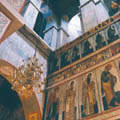 St. Sophia Cathedral - one of the most ancient Russian stone constructions - was founded by prince Yaroslav the Wise, his son Vladimir and the archbishop Luka, as a public place of worship. St. Sophia Cathedral - one of the most ancient Russian stone constructions - was founded by prince Yaroslav the Wise, his son Vladimir and the archbishop Luka, as a public place of worship.
This explains the fact that the church was dedicated to Sophia, meaning the Lord's Wisdom, the immensity of its size, and also the use of its southern gallery as a burial place of outstanding Novgorod citizens such as princes, archbishops and posadniks.
Since the 13th century the cathedral was regarded as the symbol of the city. A well-known saying went "Where there is St. Sophia, there is Novgorod." Such an attitude received further development in the beginning of the 15th century when the central dome was gilded, and a leaden pigeon, personifying the Sacred Spirit, was fixed on the central cross.
St. Sophia Cathedral of Novgorod is perfect from the architectural point of view. The architects from Byzantium and Kiev who designed it in the 11th century managed to convey the essence of the Novgorodian character through this only stone building of that time. Restraint bordering on severity, the powerful scope of thought and great strength are all elements of Novgorod culture. St. Sophia Cathedral of Novgorod differs from its Kievan predecessor in that the later building is more compact and seems to reach toward the heavens.
The original interior of the church has survived only partially. In the Martirievsky vestibule one can still see the images of St. Constantine and St. Helen, which date back to the 11th century and do not bear any resemblance to Byzantine frescos. Martirievsky vestibule one can still see the images of St. Constantine and St. Helen, which date back to the 11th century and do not bear any resemblance to Byzantine frescos.
In the 12th century the work on covering St. Sophia Cathedral with murals and frescos was completed. Today only the imposing figures of prophets over three meters in height placed in piers of the central drum, the images of saints, the ornamental mosaics in the altar part and the expressive semi-figured deisus in the southern gallery remind us of the church's former magnificence.
In the old days St. Sophia Cathedral contained an altar partition which was adorned with monumental icons dating back to the turn of the 11 th -12th centuries (fortunately some of them have survived to the present time: "Our Savior on his Throne" (Museums of the Moscow Kremlin) and "Prophets Peter and Paul" (the Novgorod Museum)). Later, in the 14th -16th centuries a tall icon-screen was installed in the cathedral. The sparkle of the silver oklady (metal icon frames), the original bright colors of the icons brought here from the Uspensky and the Rozhdestvensky icon-stands, draw the full attention of church visitors, leading their eyes to the heights of the vaults and domes.
Today the only way to enter the church is through the northe rn gates, though during archbishop's services the main gates (western gates) are opened. These gates were designed and made in the German city of Magdeburg in the 12th century. rn gates, though during archbishop's services the main gates (western gates) are opened. These gates were designed and made in the German city of Magdeburg in the 12th century.
The belfry of St. Sophia Cathedral is situated to the southeast. This five-tiered tower rises above the Kremlin walls. At the bottom of the belfry five monumental bells are on display, the ten smaller ones having been recently returned to Novgorod and installed in the Nativity Cathedral of the Antoniev monastery. All of them suffered greatly during World War II.
The first mentions of the surviving building of the belfry date back to 1437, when the spring flood of the River Volkhov brought down the wall and the kolokolnitsa (the belfry). Two years later the archbishop Euphemy II built another belfry in the place of the old one. It was repeatedly remodeled, so now only architectural and archaeological studies and images of ancient icons give us any idea of its initial shape. But no reorganization changed the essence of this structure as the main zvony (chimes) of Novgorod.
Address:
Novgorod he Great, Russia
|













 Culture and Art
Culture and Art  Architecture
Architecture  Masterpieces of Russian architecture
Masterpieces of Russian architecture